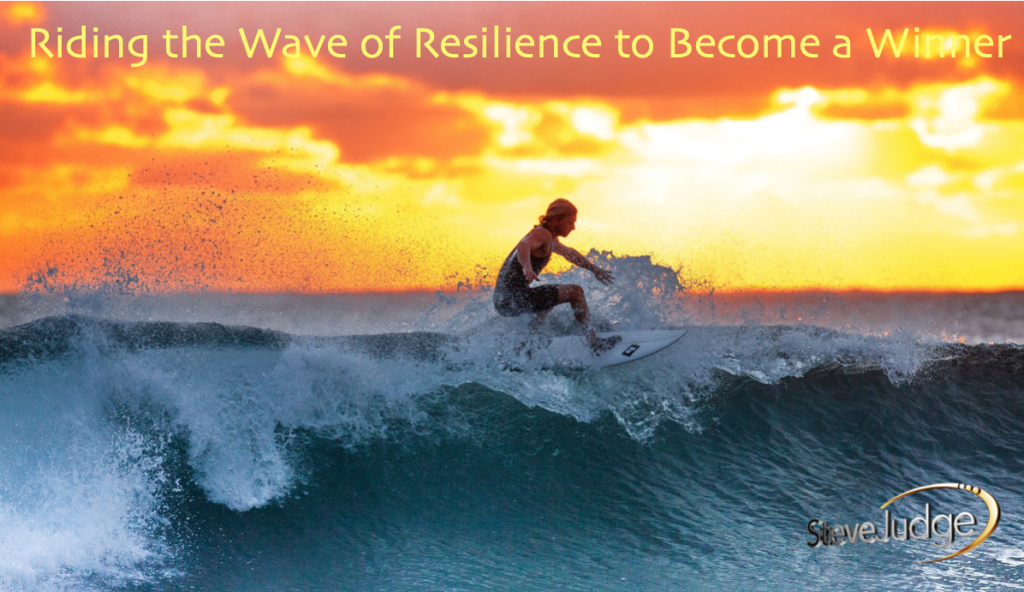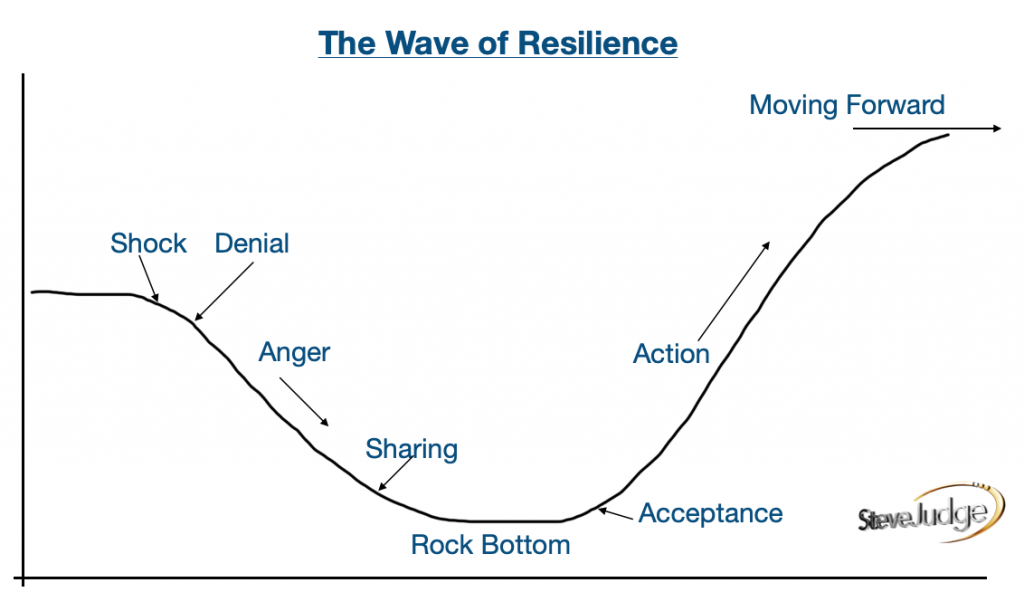8 steps that beat the back-to-work blues by enabling you to ride the ‘Wave of Resilience’
Going back to work after a break is always a daunting experience, even more so when it’s a break such as the Covid 19 pandemic has forced. It’s been epic in how it’s been disruptive along with many changes and even adversity. Going back to work in a face to face environment we may encounter a backlog of work, new targets or systems, or looming deadlines – alongside all the usual criticism, office politics and pressures from our personal lives.

What is Resilience?
One way we can deal with all this is by riding ‘The Wave of Resilience’. Resilience is your capacity to respond to the pressures and challenges brought about by everyday life. In essence, it is about how get up after being knocked down from difficult circumstances, disappointment and failure. Our approach to life and our ability to work (and live) through adversity to some extent determines our experiences.

Reach Your New Reality
The good news is that by riding the wave means you’re able to cope with change and adversity that life throws at you and it also means that by using certain skills and techniques you can then strengthen your resilience for future encounters. Understanding what you’re going through both physically and mentally will help you to accept the phase you are in which will enable you to move forward into the next phase and through the process eventually reaching your new reality.
When there is an event, a change or adversity hits us there are three phases we go through which include a total of eight processes. Your awareness of this system is a major player in coping with what’s happening with you so that you can respond, recover and move forward.
The three phases that you go through are:
1. Information
2. Response
3. Support
These phases take you from the ‘trigger’ to the ‘new reality’
Breaking these three phases down into the eight processes is where the critical workings really come in to play.
“So what are they?” I hear you ask.
Well, let’s start by imagining a wave that goes down and then up again, from left to right, with the ‘trigger’ adversity, change or event at the very left of the wave.

Step 1: Shock
The first reaction is always shock which releases the cortisol hormone in your brain pushing you into a fight, flight or freeze situation. Your body is physically prepared by blood pumping round your system, your eyes will dilate and you may even have a little shaking going on that feels like nervousness.

Step 2: Denial
Your brain will try to counteract this by going into the denial phase as your subconscious will attempt to hide the event somewhere in your brain so as not to be found. “Surely not, that’s ridiculous. I can’t believe it” Are phrases that you may come out with.
Cortisol will be decreased by the increasing testosterone in your body.

Step 3: Anger
Moving through step 2 there will then be realisation back to the the initial shock now mixed with the testosterone that brings you into the anger phase. This will start to drag you down the curve on the left hand side. Anger is expressed in many ways and it could be through verbal or physical forms. Sometimes it can also be brought internally and attempted to be quashed although it’s more likely to explode like a volcano at some point in the future.

Step 4: Sharing
“A problem shared is a problem halved” goes the saying and by going through the ‘sharing’ zone, oxytocin will be released which is a pain and stress relief so will calm you down. Sharing also comes in the form of blame where other people, colleagues or even objects bear the brunt of your frustration. Don’t blame the dog! It could also be through writing an email, letter or even a social media post. Always be careful how you share, once a stone is thrown you can’t retrieve it. Good forms of sharing can be through talking things through with HR or maybe through other means like journaling, art or poetry.
Knowing the process means that as you experience anger you can say to yourself. “Yes, I’m angry and I’ll be needing to share my frustration and blame” which will help you to take control. Once again, let me iterate that there is no avoidance of the system so the sooner you pass through each step in the best way the better. This is what I help people with in my workshops.

Step 5: Rock Bottom
The next phase is ‘Rock bottom’ and can be a really dark place that can vary from sulking to more serious depression. At this point you may put too much focus on small problems or behave inappropriately. Cortisol is released again but to be honest your hormones will be all over the place causing imbalance which will effect your behaviour and your mood. When you are feeling low then you can talk to yourself once again and ask yourself whether or not you are are prepared to accept the situation yet because if you are then you can start taking action…the fun stuff. However, we all need a little ‘down time’ and you can only move out of ‘rock bottom’ when you are good and ready. “Fall seven, rise eight.”

Step 6: Acceptance
Acceptance is very much about things coming in to balance. Your subconscious is in line with your conscious. Serotonin is released helping you to take stock of the situation and thinking clearly about what you can do rather than what you can’t do. You develop a growth mindset enabling you to accept the learnings and experiences from the initial event. “There’s no such thing as failure, only feedback“

Step 7: Action
When we do finally move through the acceptance phase then you can start taking action and that’s when dopamine is released which will make you feel great. As you continue to take action and seeing results then more serotonin and oxytocin are released again making you feel awesome. This will start lifting you up the adjacent side of the curve as you continue along the wave on the right hand side.

Step 8: Moving Forward
You now reach the top of the right hand side of the curve which is your new reality as you move forward. All your hormones are back in balance and you can see clearly your vision that you’ve been working towards. When done efficiently with the correct tools and techniques you’ll actually end up on a higher plain than where you started. Not only are you in a better place than where you used to be but you are also experienced and well equipped for your next challenge. “One guarantee in life is that there will always be challenges.“
It’s not just knowing the wave of resilience model that will help you but it’s also knowing the the tools and techniques that can support you in each phase or even speed up your journey.
On my webinars and workshops I share my unique experiences and knowledge as well as the tools and methods that I have used on my own journey. I’ll demonstrate the many times I used my resilience to pick myself up after being knocked down both mentally and physically enabling myself to go from wheelchair to world champion.
Attending my sessions will prepare you for future challenges and obstacles enabling you to ride the ‘Wave of Resilience’ so you too can become a winner within your own right.
Click here to enquire about future webinars and workshops:
Life is very much down to choices. “Even when you can’t control things that are happening to you, you can control how you react to those things.”
